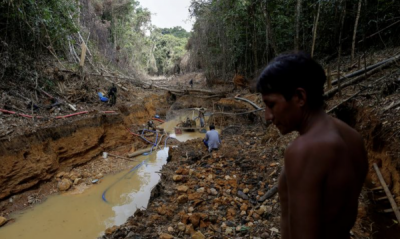What Is Dirty Gold? How Illegally Mined Gold Enters the Market (2025 Update)
Disclosure: We are reader-supported. If you purchase from a link on our site, we may earn a commission. Learn more
Last Updated on: 13th June 2025, 02:20 am
As gold prices continue to rise in 2025, so does the demand for physical bullion. But not all gold is created equal. A growing share of the world’s gold supply is mined illegally, harming ecosystems, funding criminal enterprises, and violating human rights. This so-called “dirty gold” often finds its way into mainstream refineries — even those in the U.S. In this guide, we’ll break down where dirty gold comes from, how it’s laundered into the market, and what you can do to make sure your gold is ethically sourced.
Netflix's documentary series Dirty Money helped spotlight the issue of illegal gold mining in a 2019 episode titled “Dirty Gold.” Since then, the global issue of conflict gold has only intensified. With rising gold prices in 2025 and greater demand from investors, the problem of “dirty gold” entering the supply chain remains highly relevant.
Table of Contents
South America
Illegal mining and the sourcing of “dirty gold” is alarmingly pervasive and problematic throughout South America. Its association with criminal organizations has been widely documented, coupled with environmental degradation. In addition, there is an impact on human health resulting from the use of mercury to extract the precious metal.
Peru
Nearly 60% of Peru’s landmass consists of the Amazon rainforest. In addition, the country also contains the largest deposits of gold in all of South America, which in turn, contains some of the largest deposits in the world. In some regions, gold mining is prohibited by the Peruvian government, because of the close proximity to areas deemed national preserves, such as Tambopata National Reserve. Thus, any gold extracted in these regions is deemed illegal mining. In many respects, Peru has paid a heavy toll for that presence of the glittering precious metal.
Investigations into illegal mining throughout Peru and South America at large, have revealed that in some regions illegal mining sites are operated by criminal organizations. Moreover, as highlighted in the aforementioned Dirty Gold episode, gold has become the primary method for South American drug cartels to launder drug money. The documentary highlights the complex means by which organized crime smuggles drug money from the United States, then uses it to purchase illegally mined gold from the aforesaid regions. Shell companies are then opened as fronts, which contact American refineries that solely purchase gold from Peru. These refineries then purchase the illegal gold, in turn, sending wire transfers to banks in the United States. The banks see nothing suspicious because the transfers are from the purchase of gold mined in Peru. Additionally, investigative journalists have uncovered that in some cases these nefarious parties are extorting poverty-stricken independent miners.
With regards to environmental degradation, swaths of the Peruvian Amazon have been clear-cut in a quest for gold by illegal gold mining operations. One area of particular concern to the government is the illegal mining city of La Pampa.
“The people who we find here are not the ones who run the mining activity, who launder money. The people here are the workers. What we have to do is follow the clues to catch those who are really moving this illegal economy,” explained Fabiola Muñoz, Peru’s agriculture minister in an interview.

“It’s an example of the worst you can do to a rainforest. You cut down all the trees, in the process kill all the animals, destroy the soil, then put a very toxic substance, which is mercury, into the rivers and lakes at the rate of 185 tonnes per year. Recovery of a place with that much damage is going to take a lot longer than normal,” stated Luis Fernandez of the Centre for Amazon Scientific Innovation in an interview.
Based upon research conducted by the United States Agency for International Development (USAID), as the price of gold continues to soar, illegal mining is becoming the most profitable illegal enterprise in the country. It has become so problematic, that international efforts to curb illegal mining in Peru have continued, including updates to the 2017 US-Peru memorandum of understanding. In 2023, expanded cooperation included technology support, better enforcement training, and stricter customs inspections of Peruvian gold entering the U.S.
Brazil
Illegal gold mining has been prevalent throughout Brazil’s Amazon since the 1980s. Yet over the past half-decade, the illicit endeavor has increased exponentially in Brazil, especially in the protected indigenous Yanomami territory of the Amazon, which is roughly the size of Portugal. An estimated 20,000 illegal miners have flocked to the area in hopes of profiting from the gold rush that has swept the region.
Illegal gold mining in Brazil accelerated during the presidency of Jair Bolsonaro (2019–2023), who supported economic development of the Amazon despite environmental consequences. Though Brazil's political landscape has shifted, enforcement challenges and illegal mining remain serious problems in 2025.
Former President Bolsonaro was a supporter of mining projects in protected lands. His rhetoric emboldened illegal operations, some of which persist despite government crackdowns under the current administration.
With a total population of approximately 38,000 people, the Yanomami are the largest relatively isolated indigenous group in Latin America. An estimated 26,700 people live within Brazil’s Yanomami reservation.
Over the past four decades, the quest for “dirty gold” in Brazil has resulted in the documented genocide of indigenous peoples including the Yanomami. Additionally, swaths of the Brazilian Amazon rainforest have been cleared for illegal mining operations.

Africa
Africa, particularly sub-Saharan Africa, is another region where the prevalence of illegal mining is concerning. A myriad of socio-economic factors have contributed to the pervasiveness of illegal operations, namely the lack of viable and sustainable employment, coupled with pervading destitution. Tantamount to South America, criminal groups throughout Africa have turned to illicit mining and smuggling.
In a 2019 report, Reuters exposed the scale of African gold smuggling. Since then, the UAE and African nations have faced increased scrutiny from NGOs and international regulators. In 2024, the OECD released updated guidelines urging refineries and investors to verify the origins of African-sourced gold.
How to Avoid Illegally Sourced Gold
Because of the pervasiveness of illegally mined gold, especially in regions that are major suppliers of the precious metal, it can be difficult to feasibly avoid “dirty gold”. Ultimately, the onus falls upon those within the gold supply chain itself.
The World Gold Council has openly addressed the problem of illegal artisanal and small-scale mining (ASM) operations.
“In some countries, illegal artisanal and small-scale mining (ASM) is associated with wider criminal activities. Where there are concerns about criminal activities or about the presence of illegal armed groups associated with local ASM, the large-scale mining industry has a responsibility to ensure that it does not support or facilitate such activities.”
The council asserts that legitimate large-scale gold mining companies have the potential to combat illicit gold mining practices.
“The leading role of governments in formalizing ASM and in improving social and environmental practices is of fundamental importance. We recognise, however, that where a host government provides such leadership other actors in civil society and business may have an important supporting role to play. Any such role for LSM companies will vary according to the local context. However, as part of their role in supporting dialogue and engagement, large scale gold mining companies may consider a number of options including:
- Working with governments and other actors to combat breaches of human rights associated with abusive ASM activities; to promote awareness of, and access to, technologies that reduce environmental and worker safety risks and improve yields; and promoting awareness of the dangers of the worst forms of child labor, modern slavery and gender-based violence.
- Where such intelligence becomes available, passing information to national authorities and national and international law enforcement agencies about the activities of criminal organizations intended to intimidate, extort or exploit, ASM groups.
As of mid-2025, gold prices have surpassed $3,400 per ounce, increasing the incentive for criminal enterprises to exploit unregulated mining regions. This surge has made it even more important for investors to ensure their gold is ethically sourced.
Can Gold IRA Investors Avoid Dirty Gold?
Yes – if you choose the right custodian. Reputable Gold IRA providers partner with mints and suppliers that follow LBMA (London Bullion Market Association) standards and OECD conflict-free sourcing guidelines. Before opening a Gold IRA, ask your provider:
- Are your gold bars or coins LBMA-approved?
- Can you guarantee conflict-free sourcing?
- Do you have documentation proving ethical supply chain practices?
Responsible investing in 2025 means understanding where your assets come from – and avoiding dirty gold should be part of that equation.
As gold prices continue to increase, so does the incentive to capitalize on the lucrative endeavor of illegal mining. The breadth of the grave repercussions of producing “dirty gold” span from environmental degradation to human trafficking, to genocide. Investors and consumers can choose to purchase gold that has been deemed “ethically sourced”. For those investors who are interested, have a look at our top Gold IRA company reviews to get a better understanding of what is available in the space. In addition, should you be interested in offshore storage options, here are our top 5 offshore storage locations for your Gold IRA.



 Silver
Silver Gold
Gold Platinum
Platinum Palladium
Palladium Bitcoin
Bitcoin Ethereum
Ethereum

 Gold: $3,332.05
Gold: $3,332.05
 Silver: $36.28
Silver: $36.28
 Platinum: $1,372.54
Platinum: $1,372.54
 Palladium: $1,091.66
Palladium: $1,091.66
 Bitcoin: $107,230.35
Bitcoin: $107,230.35
 Ethereum: $2,416.92
Ethereum: $2,416.92